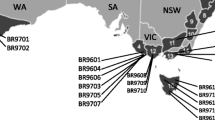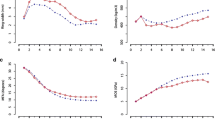Abstract
Wood basic density is among the selection criteria for many fast-grown tree species, including Pinus radiata D. Don in New Zealand. Basic density was assessed in 23,330 stem cores from 18 trials to study the heritability, the relevance of environmental effects and the magnitude of genotype-by-environment (GxE) interaction. Site differences in annual average temperature dominated variability in this dataset, with lower latitude and altitude (i.e. warmer) sites displaying higher average density. Between highest- and lowest-density sites there was an 18% difference (302.7 vs. 358.4 kg m − 3) for the linear mean for cores of rings 1–5 and a 39% difference (329.7 vs. 459.1 kg m − 3) for the linear mean of rings 6–10. The estimated heritabilities fluctuated between 0.28 and 0.94 (mean, 0.6); however, basic density displayed little within-site variability (phenotypic coefficient of variation, <8%). Bivariate analyses were used to estimate between-site genetic correlations as an indication of GxE interaction. Only 57 out of the 153 pairs of trials contained enough information to estimate the between-site genetic correlations and, out of those, 15 estimates were not statistically significant. Moderate to high (0.46–0.96) significant genetic correlation estimates indicated that there was little interaction for basic density, suggesting no need to modify the breeding strategy to account for differential performance in this trait. Poor connectedness between trials could be depressing estimates of genetic correlations. This situation should be considered when designing genetic testing schemes, particularly when purposely inducing imbalance as in rolling front strategies.



Similar content being viewed by others
References
Apiolaza LA (2009) Very early selection for solid wood quality: screening for early winners. Ann For Sci 66:601
Apiolaza LA, Garrick DJ (2001) Analysis of longitudinal data from progeny tests: some multivariate approaches. For Sci 47:129–140
Apiolaza LA, Burdon RD, Garrick DJ (1999) Effect of univariate subsampling on the efficiency of bivariate parameter estimation and selection using half-sib progeny tests. For Genet 6:79–87
Baltunis BS, Wu HX, Dungey HS, Mullin TJ, Brawner JT (2009) Comparisons of genetic parameters and clonal value predictions from clonal trials and seedling base population trials of radiata pine. Tree Genet Genomes 5:269–278
Borralho NMG, Dutkowski GW (1998) Comparison of rolling front and discrete generation breeding strategies for trees. Can J For Res 28:987–993
Bouffier L, Charlot C, Raffin A, Rozenberg P, Kremer A (2008) Can wood density be efficiently selected at early stage in maritime pine (Pinus pinaster Ait.)? Ann For Sci 65:106p1–106p8
Burdon RD (1977) Genetic correlation as a concept for studying genotype-environment interaction in forest tree breeding. Silvae Genet 26:168–175
Carson SD (1991) Genotype x environment interaction and optimal number of progeny test sites for improving Pinus radiata in New Zealand. New Zealand J For Sci 21:32–49
Cooper M, DeLacy IH (1994) Relationships among analytical methods used to study genotypic variation and genotype-by-environment interaction in plant breeding multi-environment experiments. Theor Appl Genet 88:561–572
Costa e Silva J, Potts BM, Dutkowski GW (2006) Genotype by environment interaction for growth of Eucalyptus globulus in Australia. Tree Genet Genomes 2:61–75
Cown DJ (1992) New Zealand radiata pine and Douglas fir—suitability for processing. FRI Bulletin 168, Forest Research Institute, 74 p
Cown DJ, McConchie DL, Young GD (1991) Radiata pine wood properties survey. FRI Bulletin 50, New Zealand Forest Research Institute, 50 p
Dungey HS, Matheson AC, Kain D, Evans R (2006) Genetics of wood stiffness and its component traits in Pinus radiata. Can J For Res 36:1165–1178
Dungey HS, Brawner JT, Burger F, Carson M, Henson M, Jefferson P, Matheson AC (2007) A new breeding strategy for Pinus radiata in New Zealand and New South Wales. Silvae Genet 58:28–38
Falconer DS (1952) The problem of environment and selection. Amer Nat 86:293–298
Freeman GH (1973) Statistical methods for the analysis of genotype–environment interactions. Heredity 31:339–354
Gapare WJ, Ivkovich M, Baltunis BS, Matheson AC, Wu HX (2009) Genetic stability of wood density and diameter in Pinus radiata D. Don plantation estate across Australia. Tree Genet Genomes 6:113–125
Gelman A, Hill J (2007) Data analysis using regression and multilevel/hierarchical models. Cambridge University Press, New York, 625 pp
Gilmour AR, Cullis BR, Welham SJ, Thompson R (2002) ASReml reference manual. New South Wales Agriculture, Orange, NSW, Australia
Goddard ME (1998) Consensus and debate in the definition of breeding objectives. J Dairy Sci 81(2):6–18
Harris JM (1965) A survey of the wood density, tracheid length, and latewood characteristics of radiata pine grown in New Zealand. FRI Technical Paper 57, New Zealand Forest Service, 31 pp
Henderson CR (1975) Best linear unbiased estimation and prediction under a selection model. Biometrics 31:423–447
Houlder D, Hutchinson M, Nix H, McMahon J (2001) ANUCLIM 5.1 users guide. Centre for Resource and Environmental Studies, The Australian National University. Canberra, Australia, 85 pp
Howarth JM, Goddard ME, Kinghorn BP (1997) Breeding strategies for targeting different breeding objectives. In: Proceedings 12th conference, Association for the Advancement of Animal Breeding and Genetics. Part One, Dubbo, NSW, Australia
Jayawickrama KJS, Carson MJ (2000) A breeding strategy for the New Zealand Radiata Pine Breeding Cooperative. Silvae Genet 49:82–90
Johnson GR (2004) Common families across test series—how many do we need? For Genet 11:103–112
Johnson GR, Burdon RD (1990) Family-site interaction in Pinus radiata: implications for progeny testing strategy and regionalised breeding in New Zealand. Silvae Genet 39:55–62
Kennedy BW, Trus D (1993) Considerations on genetic connectedness between management units under an animal model. J Anim Sci 71:2341–2352
Kimberley MO, West GG, Dean MG, Knowles LR (2005) The 300 Index—a volume productivity index for radiata pine. New Zealand J For 50:13–18
Kumar S (2004) Genetic parameter estimates for wood stiffness, strength, internal checking, and resin bleeding for radiata pine. Can J For Res 34:2601–2610
Li L, Wu HX (2005) Efficiency of early selection for rotation-aged growth and wood density traits in Pinus radiata. Can J For Res 35:2019–2029
Li Y, Dutkowski GW, Apiolaza LA, Pilbeam DJ, Costa e Silva J, Potts BM (2007) The genetic architecture of a Eucalyptus globulus full-sib breeding population in Australia. For Genet 12:167–179
Matheson AC, Wu HX (2005) Genotype by environment interactions in an Australia-wide radiata pine diallel mating experiment: implications for regionalized breeding. For Sci 51:29–40
McDonald TM (2009) Making sense of genotype × environment interaction of Pinus radiata in New Zealand. Ph.D. thesis, School of Forestry, University of Canterbury, Christchurch, New Zealand
Muir W, Nyquist WE, Xu S (1992) Alternative partitioning of the genotype-by-environment interaction. Theor Appl Genet 84:193–200
Nicholls JWP, Morris JD, Pederick LA (1980) Heritability estimates of density characteristics in juvenile pinus radiata wood. Silvae Genet 29:54–61
Development Core Team (2008) R: a language and environment for statistical computing. R Foundation for Statistical Computing, Vienna, Austria URL: http://www.R-project.org
Sae-Lim P, Komen H, Kause A (2010) Bias and precision of estimates of genotype-by-environment interaction. Aquaculture 310:66–73
Shelbourne CJA (1972) Genotype-environment interaction: its study and its implications in forest tree improvement. In: IUFRO Genetics SABRAO joint symposium, Tokyo, Japan
Westcott B (1986) Some methods of analysing genotype–environment interaction. Heredity 56:243–253
Wielinga B, Raymond CA, James R, Matheson AC (2009) Genetic parameters and genotype by environment interactions for green and basic density and stiffness of Pinus radiata D. Don estimated using acoustics. Silvae Genet 58:112–122
Zamudio F, Baettyg R, Vergara A, Guerra F, Rozenberg P (2002) Genetic trends in wood density and radial growth with cambial age in a radiata pine progeny test. Ann For Sci 59:541–549
Acknowledgments
Data and funding for this project were provided by the New Zealand Radiata Pine Breeding Company (NZRPBC). Many thanks to Paul Jefferson (RPBC) for compiling the phenotypic dataset, Carolyn Raymond (Southern Cross University) for the environmental data for trial D and John C.F. Walker (University of Canterbury) for comments on the manuscript. Rowland Burdon, Tony Shelbourne and two anonymous referees contributed helpful comments that improved this article.
Author information
Authors and Affiliations
Corresponding author
Additional information
Communicated by R. Burdon
Rights and permissions
About this article
Cite this article
Apiolaza, L.A. Basic density of radiata pine in New Zealand: genetic and environmental factors. Tree Genetics & Genomes 8, 87–96 (2012). https://doi.org/10.1007/s11295-011-0423-1
Received:
Revised:
Accepted:
Published:
Issue Date:
DOI: https://doi.org/10.1007/s11295-011-0423-1




